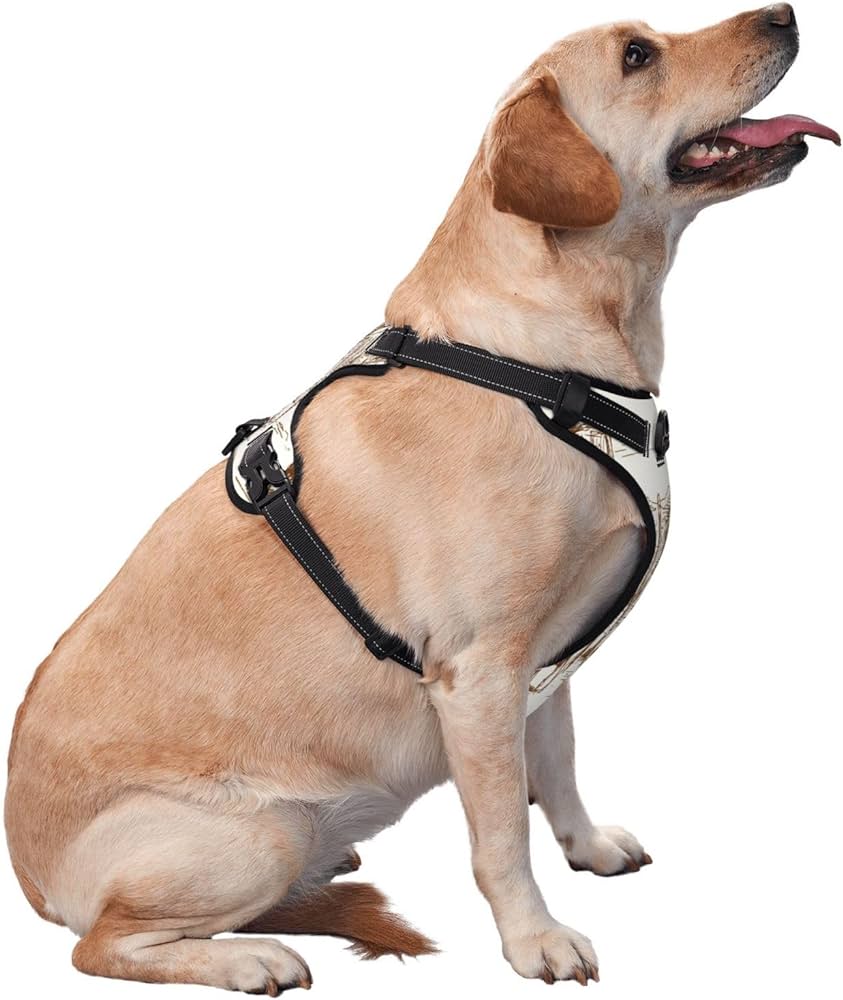In the dynamic world of pet care, where the bond between humans and dogs continues to deepen, the significance of effective training tools cannot be overstated. Among these tools, the dog training harness has emerged as a versatile and indispensable aid for pet owners committed to fostering positive behavior and ensuring the well-being of their furry companions.
As we embark on a journey to explore the nuances of choosing the best dog training harness, it becomes evident that this decision goes beyond mere functionality – it encapsulates a commitment to humane training practices, promoting safety during walks, and establishing a harmonious relationship between pet and owner.
The evolution of dog training harnesses mirrors the evolution of our understanding of canine behavior. Gone are the days of relying solely on traditional collars that could inadvertently cause discomfort or injury. The contemporary dog training harness is designed with a holistic approach, acknowledging the diverse needs of dogs in various stages of training and ensuring a balance between control, comfort, and positive reinforcement.
In this comprehensive guide, we will delve into the myriad aspects of dog training harnesses, ranging from their fundamental purposes to the various types available in the market. We will explore the critical factors to consider when making a selection, including materials, construction, size, fit, ease of use, safety features, and budget considerations.
As we unravel the layers of this essential canine accessory, it becomes evident that choosing the best dog training harness is not just a pragmatic decision; it’s a commitment to the well-being and positive development of our loyal companions. So, let us embark on this journey to discover the key elements that define the pinnacle of dog training harnesses, ensuring that our furry friends walk comfortably, train effectively, and thrive in the companionship they share with us.
Purpose of a Dog Training Harness:
Dog training harnesses serve a multifaceted role in the holistic development and well-being of our canine companions. Understanding their primary purposes is essential for pet owners looking to integrate these tools seamlessly into their training routines:
a. Encouraging Positive Behavior:
Training harnesses provide an effective means of reinforcing positive behaviors in dogs. By redirecting attention and discouraging undesirable actions, they contribute to the establishment of good habits.
b. Reducing Pulling:
One of the most common challenges during walks is excessive pulling on the leash. Harnesses, particularly those with front-clip designs, help minimize pulling by distributing pressure more evenly across the chest rather than the neck, making walks more enjoyable for both the dog and the owner.
c. Enhancing Control:
Harnesses offer superior control, especially in situations where a dog may become overly excited or agitated. The back-clip and dual-clip designs provide pet owners with a firm grip, allowing them to guide and manage their dogs more effectively.
d. Ensuring Comfort and Safety:
Designed with the dog’s comfort in mind, training harnesses avoid placing pressure on the sensitive neck area, reducing the risk of injury or discomfort. Padded designs and adjustable straps contribute to a snug fit, ensuring the dog’s well-being during walks and training sessions.
e. Facilitating Training Exercises:
Harnesses serve as an excellent tool for incorporating various training exercises into a dog’s routine. The presence of a handle on the back of the harness allows owners to guide and control their dogs during specific training drills.
f. Promoting Positive Associations:
The use of a harness, when introduced and used positively, can create a positive association with training and walking activities. This helps in building trust between the owner and the dog, fostering a cooperative and enjoyable training experience.
g. Adapting to Different Stages of Training:
The diversity in harness designs caters to dogs in various stages of training. Whether teaching basic obedience to a puppy or addressing specific behavioral issues in an adult dog, the right harness can be tailored to the individual needs of the canine companion.
h. Minimizing Choking Risks:
Unlike traditional collars that may pose a choking risk, harnesses distribute pressure more evenly, reducing the likelihood of respiratory issues or injury. This is particularly crucial for breeds prone to respiratory problems.
i. Building a Strong Bond:
Through consistent and positive training experiences facilitated by harnesses, a strong bond between the owner and the dog can be forged. The collaborative nature of harness-assisted training fosters communication and understanding, strengthening the human-canine relationship.
Conclusion:
As we draw the leash on our exploration of the world of dog training harnesses, it becomes evident that this essential accessory transcends its utilitarian role. Choosing the best dog training harness is not a mere procurement decision but an investment in the overall well-being and training journey of our four-legged companions.
In the tapestry of canine training, the harness emerges as a versatile tool, serving purposes that extend far beyond traditional collars. It stands as a testament to our evolving understanding of canine behavior and the commitment to nurturing positive habits in our dogs.
Through the careful consideration of factors such as type, materials, size, fit, ease of use, safety features, and budget, pet owners can navigate the myriad options available in the market. The right harness becomes a conduit for positive reinforcement, encouraging good behavior, and ensuring the safety and comfort of our beloved pets during walks and training sessions.
The journey to the perfect dog training harness is more than a quest for control; it is a pilgrimage toward a symbiotic relationship where communication, trust, and cooperation thrive. As we equip ourselves with the knowledge gained from this comprehensive guide, we empower ourselves to be discerning consumers and compassionate trainers.
In conclusion, the best dog training harness is not just a tool – it is a bridge between two worlds, forging a connection that goes beyond walks and commands. It is a testament to the profound partnership we share with our dogs, where training is not just about control but a celebration of shared experiences and mutual growth. So, may your walks be enjoyable, your training sessions fruitful, and your bond with your canine companion strengthened by the thoughtful choice of the perfect dog training harness.
FAQs
Q1: What is the purpose of using a dog training harness?
A1: The primary purpose of a dog training harness is to provide a humane and effective tool for training and walking dogs. It encourages positive behavior, reduces pulling, enhances control, ensures comfort and safety, and facilitates various training exercises, fostering a strong bond between the owner and the dog.
Q2: What types of dog training harnesses are available, and how do they differ?
A2: There are several types of dog training harnesses, including front-clip, back-clip, dual-clip, and no-pull designs. Front-clip harnesses discourage pulling, back-clip harnesses offer comfort and freedom, dual-clip harnesses provide versatility, and no-pull harnesses are specifically designed to curb pulling behavior.
Q3: How do I choose the right size and fit for a dog training harness?
A3: Accurate measurements of your dog’s chest girth and neck size are crucial. Follow the manufacturer’s sizing chart, and opt for a harness with adjustable straps to ensure a snug yet comfortable fit. Regularly check and readjust the harness, especially for growing puppies.
Q4: Are there specific safety features to look for in a dog training harness?
A4: Yes, safety features include reflective elements for visibility during low-light conditions, a sturdy handle for better control, and padding to prevent chafing. These features contribute to the overall safety and well-being of both the dog and the owner during walks and training sessions.
Q5: How do I introduce my dog to a training harness for the first time?
A5: Start by allowing your dog to inspect the harness, rewarding them with treats and positive reinforcement. Gradually associate the harness with enjoyable activities, such as play or walks. Keep initial sessions short and positive to create a positive association with the harness.
Q6: Can a dog training harness be used for all breeds and sizes?
A6: Yes, many harnesses are designed to accommodate a variety of breeds and sizes. It’s important to select the right size and style based on your dog’s specific needs and behaviors. Some harnesses come with sizing options tailored for small, medium, and large breeds.
Q7: What role does customer feedback play in choosing a dog training harness?
A7: Customer reviews provide valuable insights into the performance, durability, and user satisfaction of a particular harness. Consider feedback from users with dogs similar in size and behavior to make an informed decision about the harness that best suits your pet.

Jane Doe, a veterinarian with over 10 years of experience, combines her deep knowledge of animal health with a passion for pet welfare at PetsPonder.com. With a DVM degree and a commitment to the latest in veterinary science, Jane Doe offers reliable, compassionate advice to help pet owners make informed decisions for their furry companions.

Leave a Reply